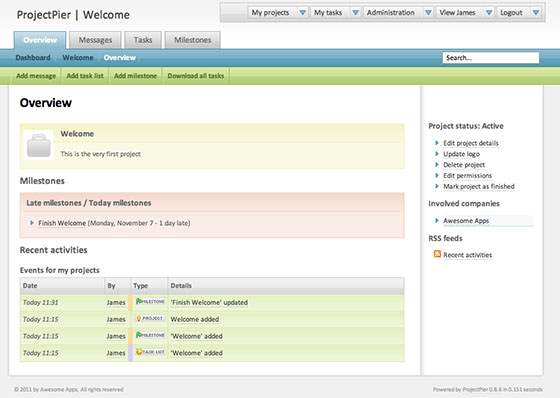
In this tutorial, we will show you how to install ProjectPier on CentOS 7. For those of you who didn’t know, ProjectPier is an open-source community aimed at developing simple, powerful, and intuitive software for web-based project management and group collaboration. ProjectPier gives you a flexible system for managing projects involving multiple organizations by providing a central place for all project activity and information while integrating with users’ existing tools. ProjectPier is freely available and licensed under the Gnu Affero General Public License (AGPL), which means you’re welcome to use and modify the software as long as any changes are distributed under the same license restrictions.
This article assumes you have at least basic knowledge of Linux, know how to use the shell, and most importantly, you host your site on your own VPS. The installation is quite simple. I will show you the step-by-step installation ProjectPier on CentOS 7.
Prerequisites
- A server running one of the following operating systems: CentOS 7.
- It’s recommended that you use a fresh OS install to prevent any potential issues.
- SSH access to the server (or just open Terminal if you’re on a desktop).
- A
non-root sudo useror access to theroot user. We recommend acting as anon-root sudo user, however, as you can harm your system if you’re not careful when acting as the root.
Install ProjectPier on CentOS 7
Step 1. First of all, make sure that all packages are up to date.
yum -y update
Step 2. Install the LAMP server and include some PHP extensions.
yum install mariadb mariadb-server httpd php php-common php-gd php-ldap php-xml
Start service Apache web server and MariaDB also enable it to start on boot of the server:
systemctl start httpd systemctl start mariadb systemctl enable httpd systemctl enable mariadb
Step 3. Configuring MariaDB for ProjectPier.
By default, MariaDB is not hardened. You can secure MariaDB using the mysql_secure_installation script. you should read and below each step carefully which will set a root password, remove anonymous users, disallow remote root login, and remove the test database and access to secure MariaDB.
mysql_secure_installation
Next, we will need to log in to the MariaDB console and create a database for the forum. Run the following command:
mysql -u root -p
This will prompt you for a password, so enter your MariaDB root password and hit Enter. Once you are logged in to your database server you need to create a database for the ProjectPier software:
CREATE DATABASE projectpier CHARACTER SET utf8; GRANT ALL PRIVILEGES ON projectpier.* TO 'projectpier'@'localhost' IDENTIFIED BY 'your_projectpier_passwd'; FLUSH PRIVILEGES; \q
Configure your server to support InnoDB, if it is not set by default, and increase the max_allowed_packet variable to 128MB
###nano /etc/my.cnf #skip-innodb max_allowed_packet = 128M
Step 4. Install ProjectPier.
Download the latest stable version of ProjectPier, At the moment of writing this article it is version 0.8.8:
cd /opt/ wget http://www.projectpier.org/files/pp088wSP2_2014-08-14.zip mkdir -p /var/www/html/projectpier unzip -d /var/www/html/projectpier pp088wSP2*.zip
Step 5. Configure Apache web server for ProjectPier.
Create a new virtual host in Apache:
###nano /etc/httpd/conf/httpd.conf <VirtualHost YOUR_SERVER_IP:80> ServerAdmin webmaster@your-domain.com DocumentRoot "/var/www/html/projectpier" ServerName your-domain.com ServerAlias www.your-domain.com ErrorLog "/var/log/httpd/your-domain.com-error_log" CustomLog "/var/log/httpd/your-domain.com-access_log" combined <Directory "/var/www/html/your-domain.com/"> DirectoryIndex index.html index.php Options FollowSymLinks AllowOverride All Require all granted </Directory> </VirtualHost>
Restart the Apache service for the changes to take effect:
systemctl restart httpd
We will need to change some folders permissions:
chown -R apache:apache /var/www/html/projectpier
Step 6. Accessing ProjectPier.
ProjectPier will be available on HTTP port 80 by default. Open your favorite browser and navigate to http://your-domain.com/public/install or http://server-ip/public/install and complete the required steps to finish the installation. If you are using a firewall, please open port 80 to enable access to the control panel.

Congratulations! You have successfully installed ProjectPier. Thanks for using this tutorial for installing ProjectPier on CentOS 7 system. For additional help or useful information, we recommend you check the official ProjectPier website.